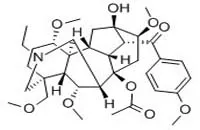| In vitro: |
| Anesthesiology. 2007 Jul;107(1):82-90. | | Bulleyaconitine A isolated from aconitum plant displays long-acting local anesthetic properties in vitro and in vivo.[Pubmed: 17585219] | Bulleyaconitine A (BLA) is an active ingredient of Aconitum bulleyanum plants. Bulleyaconitine A has been approved for the treatment of chronic pain and rheumatoid arthritis in China, but its underlying mechanism remains unclear.
METHODS AND RESULTS:
The authors examined (1) the effects of Bulleyaconitine A on neuronal voltage-gated Na channels in vitro under the whole cell patch clamp configuration and (2) the sensory and motor functions of rat sciatic nerve after single Bulleyaconitine A injections in vivo. Bulleyaconitine A at 10 microm did not affect neuronal Na currents in clonal GH3 cells when stimulated infrequently to +50 mV. When stimulated at 2 Hz for 1,000 pulses (+50 mV for 4 ms), Bulleyaconitine A reduced the peak Na currents by more than 90%. This use-dependent reduction of Na currents by Bulleyaconitine A reversed little after washing. Single injections of Bulleyaconitine A (0.2 ml at 0.375 mm) into the rat sciatic notch not only blocked sensory and motor functions of the sciatic nerve but also induced hyperexcitability, followed by sedation, arrhythmia, and respiratory distress. When Bulleyaconitine A at 0.375 mm was coinjected with 2% lidocaine (approximately 80 mm) or epinephrine (1:100,000) to reduce drug absorption by the bloodstream, the sensory and motor functions of the sciatic nerve remained fully blocked for approximately 4 h and regressed completely after approximately 7 h, with minimal systemic effects.
CONCLUSIONS:
Bulleyaconitine A reduces neuronal Na currents strongly at +50 mV in a use-dependent manner. When coinjected with lidocaine or epinephrine, Bulleyaconitine A elicits prolonged block of both motor and sensory functions in rats with minimal adverse effects. |
|
| In vivo: |
| Exp Neurol. 2015 Nov;273:263-72. | | Bulleyaconitine A depresses neuropathic pain and potentiation at C-fiber synapses in spinal dorsal horn induced by paclitaxel in rats.[Pubmed: 26376216 ] | Paclitaxel, a widely used chemotherapeutic agent, often induces painful peripheral neuropathy and at present no effective drug is available for treatment of the serious side effect.
METHODS AND RESULTS:
Here, we tested if intragastrical application of Bulleyaconitine A (BLA), which has been approved for clinical treatment of chronic pain in China since 1985, could relieve the paclitaxel-induced neuropathic pain. A single dose of BLA attenuated the mechanical allodynia, thermal hyperalgesia induced by paclitaxel dose-dependently. Repetitive administration of the drug (0.4 and 0.8 mg/kg, t.i.d. for 7 d) during or after paclitaxel treatment produced a long-lasting inhibitory effect on thermal hyperalgesia, but not on mechanical allodynia. In consistency with the behavioral results, in vivo electrophysiological experiments revealed that spinal synaptic transmission mediated by C-fiber but not A fiber was potentiated, and the magnitude of long-term potentiation (LTP) at C-fiber synapses induced by the same high frequency stimulation was ~50% higher in paclitaxel-treated rats, compared to the naïve rats. Spinal or intravenous application of BLA depressed the spinal LTP, dose-dependently. Furthermore, patch clamp recordings in spinal cord slices revealed that the frequency but not amplitude of both spontaneous excitatory postsynaptic current (sEPSCs) and miniature excitatory postsynaptic currents (mEPSCs) in lamina II neurons was increased in paclitaxel-treated rats, and the superfusion of BLA reduced the frequency of sEPSCs and mEPSCs in paclitaxel-treated rats but not in naïve ones.
CONCLUSIONS:
Taken together, we provide novel evidence that BLA attenuates paclitaxel-induced neuropathic pain and that depression of spinal LTP at C-fiber synapses via inhibiting presynaptic transmitter release may contribute to the effect. | | Anesth Analg. 2008 Oct;107(4):1397-405. | | Use of bulleyaconitine A as an adjuvant for prolonged cutaneous analgesia in the rat.[Pubmed: 18806059] | Bulleyaconitine A (BLA) is an analgesic and antiinflammatory drug isolated from Aconitum plants. BLA has several potential targets, including voltage-gated Na+ channels. We tested whether BLA elicited long-lasting cutaneous analgesia, when co-injected with lidocaine and epinephrine, as a model for prolonged infiltration anesthesia.
METHODS AND RESULTS:
The local anesthetic properties of BLA were assessed by the patch-clamp technique in HEK293t cells expressing Nav1.7 and Nav1.8 neuronal Na+ channels, both crucial for nociception. Drug solutions (0.6 mL) were injected subcutaneously via rat shaved dorsal skin. Inhibition of the cutaneous trunci muscle reflex was evaluated by pinpricks. Skin cross-sections were stained with hematoxylin and eosin or with antibodies against PGP9.5.
BLA at 10 microM interacted minimally with resting or inactivated Nav1.7 and Nav1.8 Na+ channels when infrequently stimulated to +50 mV for 3 ms. However, when stimulated at 2 Hz for 1000 pulses, their peak Na+ currents were >90% reduced by BLA. This use-dependent inhibition was not significantly reversed after 15-min washing. Complete nociceptive blockade after injection of lidocaine (0.5%)/epinephrine (1:200,000) lasted for approximately 1 h in rats; full recovery occurred after approximately 6 h. Co-injection of 0.125 mM BLA with lidocaine/epinephrine increased the duration of complete nociceptive blockade to 24 h. Full recovery occurred after approximately 6 days. Skin histology including peripheral nerve fibers appeared unaffected by BLA.
CONCLUSIONS:
BLA inhibits Nav1.7 and Nav1.8 Na+ currents in a use-dependent manner. Co-injection of BLA at |
|






 Cell. 2018 Jan 11;172(1-2):249-261.e12. doi: 10.1016/j.cell.2017.12.019.IF=36.216(2019)
Cell. 2018 Jan 11;172(1-2):249-261.e12. doi: 10.1016/j.cell.2017.12.019.IF=36.216(2019) Cell Metab. 2020 Mar 3;31(3):534-548.e5. doi: 10.1016/j.cmet.2020.01.002.IF=22.415(2019)
Cell Metab. 2020 Mar 3;31(3):534-548.e5. doi: 10.1016/j.cmet.2020.01.002.IF=22.415(2019) Mol Cell. 2017 Nov 16;68(4):673-685.e6. doi: 10.1016/j.molcel.2017.10.022.IF=14.548(2019)
Mol Cell. 2017 Nov 16;68(4):673-685.e6. doi: 10.1016/j.molcel.2017.10.022.IF=14.548(2019)